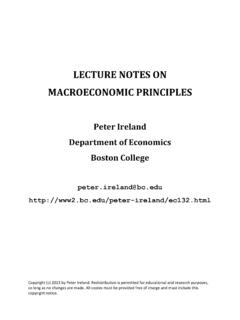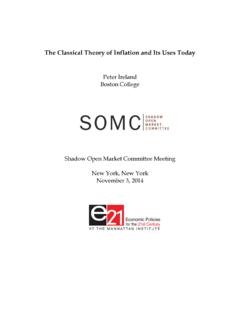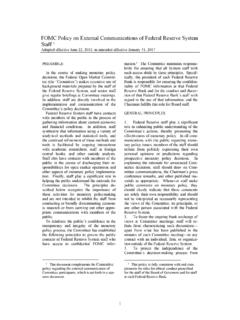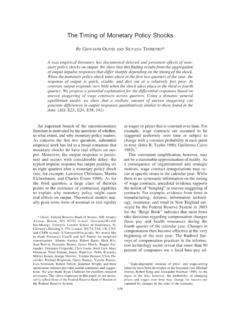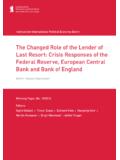Transcription of The Evolution of U.S. Monetary Policy: 2000-2007
1 THE Evolution OF Monetary policy : 2000 2007. Michael T. Belongia Peter N. Ireland Otho Smith Professor of Economics Department of Economics University of Mississippi Boston College Box 1848 140 Commonwealth Avenue University, MS 38677 Chestnut Hill, MA 02467. August 2016. Abstract: A vector autoregression with time-varying parameters is used to characterize changes in federal reserve policy that occurred from 2000. through 2007 and describe how they affected the performance of the economy. Declining coefficients in the model's estimated policy rule point to a shift in the Fed's emphasis away from stabilizing inflation over this period. More importantly, however, the Fed held the federal funds rate persistently below the values prescribed by this rule.
2 Under this more discretionary policy , inflation overshot its target and the funds rate followed a path reminiscent of the stop-go pattern that characterized Fed behavior prior to 1979. JEL Codes: C32, E31, E32, E37, E52, E58. Acknowledgments: The authors would like to thank an Associate Editor and two anonymous referees for extremely helpful comments on an earlier draft of this paper. Neither author received any external support for, or has any financial interest that relates to, the research described here. Introduction The years from 2000 through 2007 lie between two remarkable, but very different, episodes in United States economic history. The period from the mid- 1980s through 2000 exhibited extraordinary macroeconomic stability and came to be known as the Great Moderation.
3 1 December 2007, on the other hand, marked the beginning of the Great Recession, a period of economic and financial turmoil of a kind not seen in the since the Great Depression. The timing of these events, and the sharp contrast between them, suggest that something fundamental must have changed between 2000 and 2007. The statistical analysis presented here is directed at assessing the role Monetary policy may have played as a possible source of that change. Its focus on Monetary policy is motivated by two interrelated sets of considerations. First, a host of studies, including Clarida, Gali, and Gertler (2000), Gali, Lopez- Salido, and Valles (2003), Lubik and Schorfheide (2004), and Boivin and Giannoni (2006), present evidence that links the improved performance of the economy during the Great Moderation to better Monetary policymaking.
4 In particular, these studies find that, in the early 1980s, Monetary policy began to place more emphasis on stabilizing inflation and less on stabilizing output and employment. These studies go on to argue that this shift in the federal reserve 's focus removed Monetary policy itself as a source of business cycle 1 Kim and Nelson (1999), McConnell and Perez-Quiros (2000), and Stock and Watson (2002) establish 1984 as the starting date for this period. Although there is, as yet, no similar consensus as to when the Great Moderation came to a close, it suffices for now to note that over the 16 years that followed, steady growth in aggregate income and employment was interrupted by only one, relatively minor, recession lasting from March through November 1991.
5 1. fluctuations and helped the economy respond more efficiently to a range of non- Monetary disturbances. If these arguments are correct, a shift in emphasis back towards smoothing fluctuations in the real economy around 2000 may have created conditions conducive to the reemergence since then of Monetary disturbances as a source of inefficient fluctuations. Taylor (2009) offers a different interpretation of events by arguing that the federal reserve began to deviate persistently from the prescriptions of his original (1993) rule and, in so doing, set the stage for the financial crisis of 2007 and the Great Recession that followed. His (2009) comparison of the actual trajectory of the federal funds rate from 2000 through 2007 against the values prescribed by his original (1993) rule suggests that Monetary policy had been too accommodative over most of this period and fueled a boom-bust cycle in housing and other interest-sensitive sectors of the In short, Taylor's argument is that the Fed abandoned the guidance of a rule and returned to policy actions guided by discretion 2 Barnett (2012, ) also blames the housing boom on overly expansionary Monetary policy in the years following 2001, arguing that federal reserve officials might have noticed this error had they used appropriate measures of money instead of the federal funds rate to gauge the stance of their policies.
6 That restrictive Monetary policy preceded the onset of recession in 2007 is an argument also made by Hetzel (2009, 2012). 3 The contrast drawn here between rules and discretion comes closest to the distinction as it is made by Taylor (1993, ): The former refers to the policymaker's systematic response to changes in the economy as summarized by a small number of state variables, such as inflation and the output gap, whereas the latter alludes to less predictable actions motivated, perhaps, by the policymaker's own judgment. In contrast, Barro and Gordon's (1983). theoretical framework characterizes a discretionary policymaker as one who sets inflation too high in order to exploit a Phillips curve trade-off, but still 2. This paper attempts to draw distinctions between these alternative interpretations of how the federal reserve implemented its policy decisions during the period from 2000 through 2007.
7 To this end, it estimates a vector autoregressive time series model with time-varying parameters and stochastic volatility using Bayesian methods introduced and outlined by Cogley and Sargent (2005) and Primiceri (2005). The equation for the interest rate in this model takes the same general form as the Taylor (1993) rule, but imposes fewer constraints on the dynamics with which the federal reserve adjusts its target for the funds rate in response to changes in the economy. Thus, the model is capable of capturing a range of ways in which Monetary policy can change and, in particular, distinguishes between whether the central bank adjusted the strength of its systematic responses to inflation versus output (or unemployment) and whether it deviated from that systematic behavior to a greater or lesser extent.
8 Because it embeds this version of the Taylor Rule within a simultaneous-equation system, however, the model can be used to investigate a more general question: How changes in Monetary policy during this period affected inflation and output as well the short-term interest rate. The model sheds light, in particular, on whether macroeconomic conditions leading up to the Great Recession might have evolved differently if the Fed had not changed the weights it put on inflation versus output in the estimated rule or if it had not deviated from the behavior prescribed by that rule. behaves in a perfectly predictable manner; Ireland (1999) presents a statistical analysis designed to test whether federal reserve policy has been discretionary in this alternative sense and offers some support for this perspective.
9 3. The results point to both a shift in federal reserve policy away from stabilizing inflation between 2000 and 2007 and to important departures from rule-like behavior during that time. Moreover, counterfactual simulations conducted with the model indicate that the estimated changes in Monetary policy but especially departures from the policy rule caused inflation to be higher than it otherwise would have been when the Great Recession began. These results raise the question of whether the United States, after an interlude spanning the mid-1980s through the 1990s, entered a period of renewed Monetary instability after 2000. They underscore, as well, the advantages that accrue when central bankers respond systematically to movements in inflation and real economic activity within the context of a Monetary policy rule and avoid persistent deviations from that rule.
10 Some previous studies estimate interest rate rules with time-varying parameters to examine whether the coefficients of a Taylor rule have changed in ways that are more complex than a one-time sample split around 1979. might suggest. Work on this question includes Jalil (2004), Boivin (2006), Kim and Nelson (2006), McCulloch (2007), Trecroci and Vassalli (2001), Li (2012), Jung and Katayama (2014), Lakdawala (2015), and Lee, Morley, and Shields (2015). Other studies, such as Bayoumi and Sgherri (2004), Mandler (2007), Ang, Boivin, Dong, and Loo-Kung (2011), and Doko Tchatoka, Groshenny, Haque, and Weder (2016), go further to consider the effects that time-variation in Taylor rule parameters have had on the persistence of inflation, the predictability of the federal funds rate, the behavior of long-term bond yields, 4.

